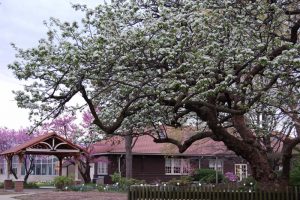There’s no better way to celebrate Arbor Day then to add beauty and value to your home landscape with a new tree. Trees can also provide shade and wind protection for many years to come if given the proper start. The last Friday in April is both the national and the Indiana Arbor Day.
The first step should be thoughtful selection of an appropriate plant to match the location. Assess your planting location for such factors as light, moisture availability, drainage, amount of space and exposure to wind. Then search for plant species that are best adapted to those conditions. Keep in mind such characteristics as winter hardiness, heat tolerance, plant size at maturity, growth rate, cultural requirements and plant hardiness. Once you have narrowed down a list of desirable plants that are adapted to your location, check local nurseries and garden centers for availability and prices.
The urban environment is different than most locations in a plant’s native range. It is an ecosystem unlike any other due to extreme environmental pressures. So landscapers and homeowners must use a wide range of plant material that will survive in these unique and often harsh environments.
Horticulturalists have continued to discover and introduce plants to broaden the plant palette. Unfortunately, a few of these landscape species can escape into wild areas and create ecological problems in unintended areas such as forests and woodlands. In Indiana, a few frequently used landscape plant species have invaded these natural areas and are displacing native species.
To help the green industry and homeowners make better-informed choices for landscape material, Purdue Extension bulletin ID-464-W, Alternative Options for
Invasive Landscape Plants, is a good start. This publication lists potential alternatives to some of the most notorious and damaging invasive plants in Indiana.
https://www.extension.purdue.edu/extmedia/ID/ID-464-W.pdf
Trees can be purchased either as bare-root, containerized or balled and burlapped (B&B). Bare-root stock should be planted while dormant, before leaves break bud. Containerized and B&B stock can be planted any time the soil can be worked. But keep in mind that waiting until hot summer days arrive will put additional stress on young trees.
Prepare the soil where the tree is to be planted well ahead of time so that the roots will not be endangered of drying out before you get them in the ground. If planting must be delayed, be sure to supply moisture to the roots. Dig an area that is larger than the root system. The hole should be at least a foot wider than the root spread or soil ball, and the sides of the hole should be vertical, not sloping. Plant the tree at the same depth it was grown in the nursery. If the hole is too deep, replace some of the soil at the bottom, but be sure to firm the soil to prevent the tree from slipping down later.
Refill the planting hole with the same soil you took out of the hole. Do not amend the backfill with organic materials such as mulch or peat moss, as it only makes root establishment more difficult once they grow beyond the amended soil, particularly in clay soils. Do not mix dry fertilizer or manure with soil as young developing roots will be easily burned.
When planting B&B stock, make sure you cut the twine or wire that binds the burlap to the trunk. If left in place, these materials will cut through the trunk as it expands in diameter, cutting the transport of carbohydrates from leaves to roots. The damage may take several years to show up, but by then it will be too late to rescue the tree.
For more information on proper planting techniques, see these Purdue Extension bulletins:
* Tree Installation: Process and Practices
https://www.extension.purdue.edu/extmedia/fnr/fnr-433-w.pdf
* Planting & Transplanting Landscape Trees and Shrubs
https://hort.purdue.edu/ext/HO-100.pdf
